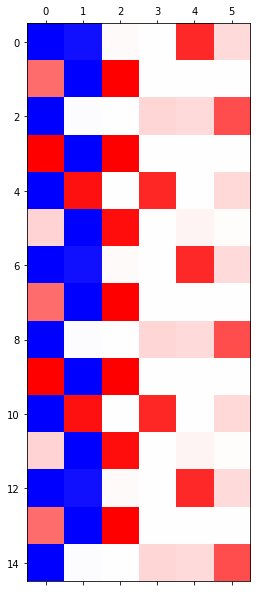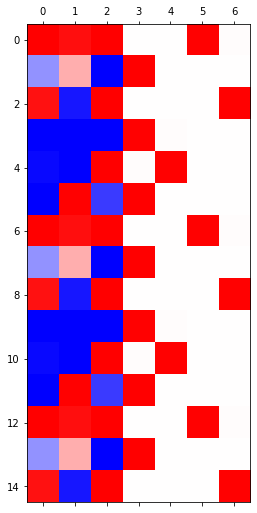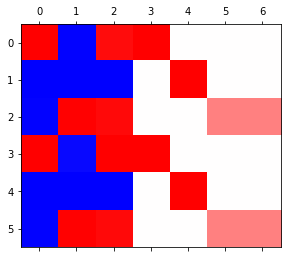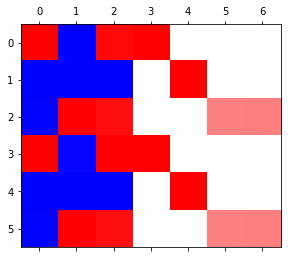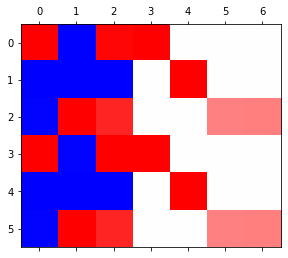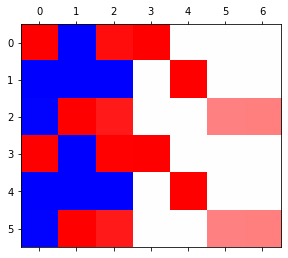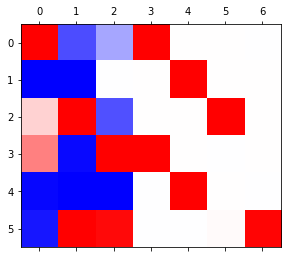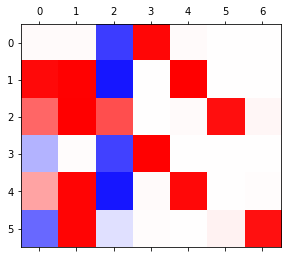RNN(2)– AbAcAd예제, GPU실험 // LSTM– abcabC, abcdabcD, LSTM의 계산과정, LSTM은 왜 강한가?
강의영상
https://youtube.com/playlist?list=PLQqh36zP38-w4os-B5ykNwxyVhjbxjXER
import
Define some funtions
Exam4: AbAcAd (2)
data
- 기존의 정리방식
순환신경망 구현1 (손으로 직접구현) – 리뷰
(1) 숙성담당 네트워크
(2) 조리담당 네트워크
(3) 손실함수, 옵티마이저 설계
(4) 학습 (6분정도 걸림)
(5) 시각화
tensor([[1.6522e-02, 6.2036e-01, 1.0433e-01, 2.5879e-01],
[9.9965e-01, 6.5788e-05, 1.8450e-05, 2.6785e-04],
[7.6673e-05, 1.9704e-01, 8.0201e-01, 8.7218e-04],
...,
[7.4634e-05, 1.9501e-01, 8.0407e-01, 8.4751e-04],
[9.4785e-01, 7.4711e-03, 6.1182e-04, 4.4064e-02],
[3.6306e-02, 1.2466e-01, 2.8862e-03, 8.3615e-01]],
grad_fn=<SoftmaxBackward0>)GPU 실험
실험결과 요약
| len | # of hidden nodes | backward | cpu | gpu | ratio |
|---|---|---|---|---|---|
| 20000 | 20 | O | 93.02 | 3.26 | 28.53 |
| 20000 | 20 | X | 18.85 | 1.29 | 14.61 |
| 2000 | 20 | O | 6.53 | 0.75 | 8.70 |
| 2000 | 20 | X | 1.25 | 0.14 | 8.93 |
| 2000 | 1000 | O | 58.99 | 4.75 | 12.41 |
| 2000 | 1000 | X | 13.16 | 2.29 | 5.74 |
Exam5: abcabC
data
RNN
- 3000 epochs
- 6000 epochs
- 9000 epochs
- 12000 epochs
- 15000 epochs
LSTM
- LSTM
- 3000 epochs
<matplotlib.image.AxesImage at 0x7f47cc0608d0>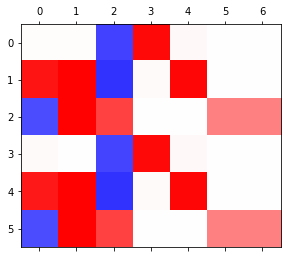
- 6000 epochs
RNN vs LSTM 성능비교실험
- RNN
fig, ax = plt.subplots(5,5,figsize=(10,10))
for i in range(5):
for j in range(5):
rnn = torch.nn.RNN(4,3).to("cuda:0")
linr = torch.nn.Linear(3,4).to("cuda:0")
loss_fn = torch.nn.CrossEntropyLoss()
optimizr = torch.optim.Adam(list(rnn.parameters())+list(linr.parameters()),lr=0.1)
_water = torch.zeros(1,3).to("cuda:0")
for epoc in range(3000):
## 1
hidden, hT = rnn(x,_water)
output = linr(hidden)
## 2
loss = loss_fn(output,y)
## 3
loss.backward()
## 4
optimizr.step()
optimizr.zero_grad()
yhat=soft(output)
combind = torch.concat([hidden,yhat],axis=1)
ax[i][j].matshow(combind.to("cpu").data[-6:],cmap='bwr',vmin=-1,vmax=1)
fig.suptitle(r"$RNN$",size=20)
fig.tight_layout()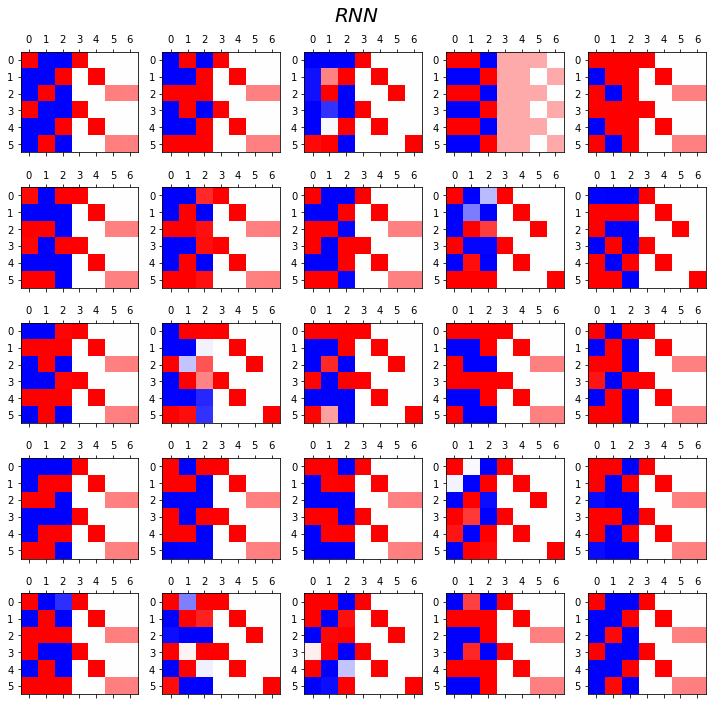
- LSTM
fig, ax = plt.subplots(5,5,figsize=(10,10))
for i in range(5):
for j in range(5):
lstm = torch.nn.LSTM(4,3).to("cuda:0")
linr = torch.nn.Linear(3,4).to("cuda:0")
loss_fn = torch.nn.CrossEntropyLoss()
optimizr = torch.optim.Adam(list(lstm.parameters())+list(linr.parameters()),lr=0.1)
_water = torch.zeros(1,3).to("cuda:0")
for epoc in range(3000):
## 1
hidden, (hT,cT) = lstm(x,(_water,_water))
output = linr(hidden)
## 2
loss = loss_fn(output,y)
## 3
loss.backward()
## 4
optimizr.step()
optimizr.zero_grad()
yhat=soft(output)
combind = torch.concat([hidden,yhat],axis=1)
ax[i][j].matshow(combind.to("cpu").data[-6:],cmap='bwr',vmin=-1,vmax=1)
fig.suptitle(r"$LSTM$",size=20)
fig.tight_layout()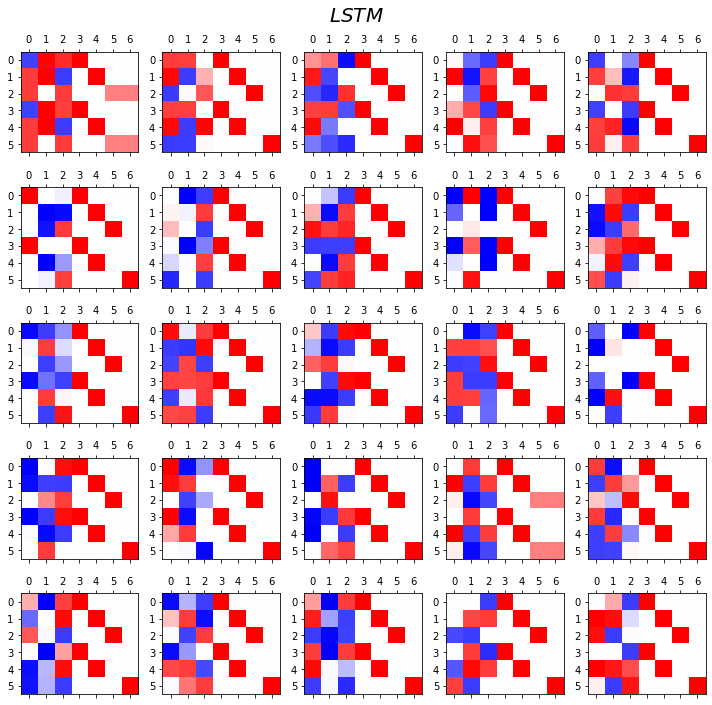
Exam6: abcdabcD
data
RNN vs LSTM 성능비교실험
- RNN
fig, ax = plt.subplots(5,5,figsize=(10,10))
for i in range(5):
for j in range(5):
rnn = torch.nn.RNN(5,4).to("cuda:0")
linr = torch.nn.Linear(4,5).to("cuda:0")
loss_fn = torch.nn.CrossEntropyLoss()
optimizr = torch.optim.Adam(list(rnn.parameters())+list(linr.parameters()),lr=0.1)
_water = torch.zeros(1,4).to("cuda:0")
for epoc in range(3000):
## 1
hidden, hT = rnn(x,_water)
output = linr(hidden)
## 2
loss = loss_fn(output,y)
## 3
loss.backward()
## 4
optimizr.step()
optimizr.zero_grad()
yhat=soft(output)
combind = torch.concat([hidden,yhat],axis=1)
ax[i][j].matshow(combind.to("cpu").data[-8:],cmap='bwr',vmin=-1,vmax=1)
fig.suptitle(r"$RNN$",size=20)
fig.tight_layout()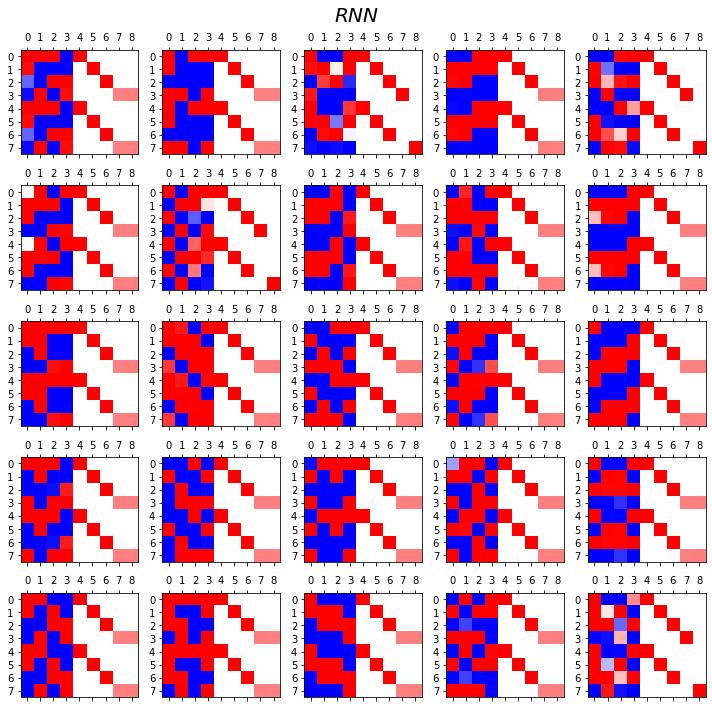
- LSTM
fig, ax = plt.subplots(5,5,figsize=(10,10))
for i in range(5):
for j in range(5):
lstm = torch.nn.LSTM(5,4).to("cuda:0")
linr = torch.nn.Linear(4,5).to("cuda:0")
loss_fn = torch.nn.CrossEntropyLoss()
optimizr = torch.optim.Adam(list(lstm.parameters())+list(linr.parameters()),lr=0.1)
_water = torch.zeros(1,4).to("cuda:0")
for epoc in range(3000):
## 1
hidden, (hT,cT) = lstm(x,(_water,_water))
output = linr(hidden)
## 2
loss = loss_fn(output,y)
## 3
loss.backward()
## 4
optimizr.step()
optimizr.zero_grad()
yhat=soft(output)
combind = torch.concat([hidden,yhat],axis=1)
ax[i][j].matshow(combind.to("cpu").data[-8:],cmap='bwr',vmin=-1,vmax=1)
fig.suptitle(r"$LSTM$",size=20)
fig.tight_layout()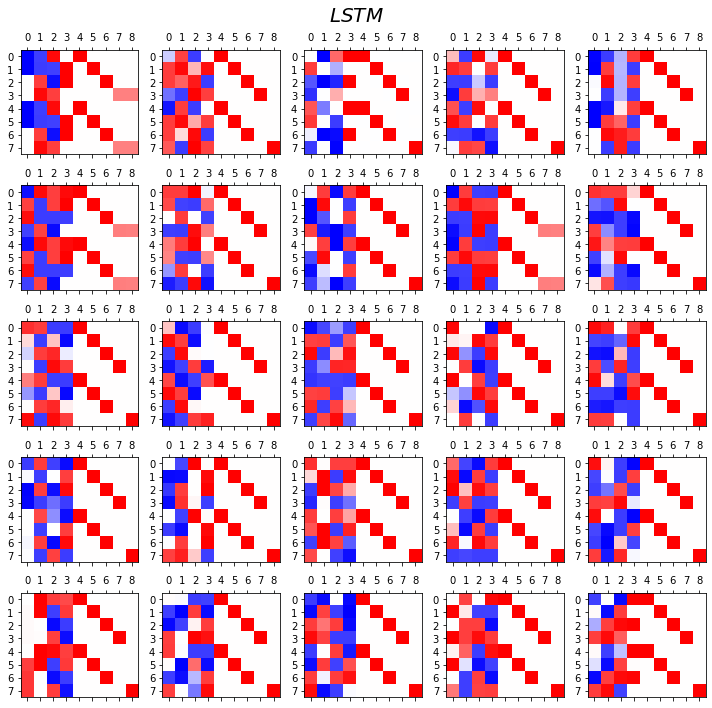
- 관찰1: LSTM이 확실히 장기기억에 강하다.
- 관찰2: LSTM은 hidden에 0이 잘 나온다.
- 사실 확실히 구분되는 특징을 판별할때는 -1,1 로 히든레이어 값들이 설정되면 명확하다.
- 히든레이어에 -1~1사이의 값이 나온다면 애매한 판단이 내려지게 된다.
- 그런데 이 애매한 판단이 어떻게 보면 문맥의 뉘앙스를 이해하는데 더 잘 맞다.
- 그런데 RNN은 -1,1로 셋팅된 상황에서 -1~1로의 변화가 더디다는 것이 문제임.
LSTM의 계산과정
data: abaB
1 epoch ver1 (with torch.nn.LSTMCell)
1 epoch ver2 (완전 손으로 구현)
t=0 \(\to\) t=1
- lstm_cell 을 이용한 계산 (결과비교용)
T = len(x)
for epoc in range(1):
ht = torch.zeros(1,2)
ct = torch.zeros(1,2)
loss = 0
## 1~2
for t in range(1):
xt,yt = x[[t]], y[[t]]
ht,ct = lstm_cell(xt,(ht,ct))
# ot = linr(ht)
# loss = loss + loss_fn(ot,yt)
# loss = loss / T
# ## 3
# loss.backward()
# ## 4
# optimizr.step()
# optimizr.zero_grad()(tensor([[-0.0541, 0.0892]], grad_fn=<MulBackward0>),
tensor([[-0.1347, 0.2339]], grad_fn=<AddBackward0>))- 이런결과를 어떻게 만드는걸까?
- https://pytorch.org/docs/stable/generated/torch.nn.LSTM.html
- 직접계산
t=0 \(\to\) t=T
T = len(x)
for epoc in range(1):
ht = torch.zeros(1,2)
ct = torch.zeros(1,2)
loss = 0
## 1~2
for t in range(T):
xt,yt = x[[t]], y[[t]]
## lstm_cell step1: calculate _ifgo
_ifgo = xt @ lstm_cell.weight_ih.T + ht @ lstm_cell.weight_hh.T + lstm_cell.bias_ih + lstm_cell.bias_hh
## lstm_cell step2: decompose _ifgo
input_gate = sig(_ifgo[:,0:2])
forget_gate = sig(_ifgo[:,2:4])
gt = tanh(_ifgo[:,4:6])
output_gate = sig(_ifgo[:,6:8])
## lstm_cell step3: calculate ht,ct
ct = forget_gate * ct + input_gate * gt
ht = output_gate * tanh(ct)
# ot = linr(ht)
# loss = loss + loss_fn(ot,yt)
# loss = loss / T
# ## 3
# loss.backward()
# ## 4
# optimizr.step()
# optimizr.zero_grad()1 epoch ver3 (with torch.nn.LSTM)
LSTM은 왜 강한가?
data: abaB
(['a', 'b', 'a', 'B', 'a', 'b', 'a', 'B', 'a', 'b'],
['b', 'a', 'B', 'a', 'b', 'a', 'B', 'a', 'b', 'a'])1000 epoch
시각화
for t in range(T):
## 1: calculate _ifgo
_ifgo = x[[t]] @ lstm.weight_ih_l0.T + h[[t]] @ lstm.weight_hh_l0.T + lstm.bias_ih_l0 + lstm.bias_hh_l0
## 2: decompose _ifgo
input_gate[[t]] = sig(_ifgo[:,0:2])
forget_gate[[t]] = sig(_ifgo[:,2:4])
g[[t]] = tanh(_ifgo[:,4:6])
output_gate[[t]] = sig(_ifgo[:,6:8])
## 3: calculate ht,ct
cell[[t]] = forget_gate[[t]] * cell[[t]] + input_gate[[t]] * g[[t]]
h[[t]] = output_gate[[t]] * tanh(cell[[t]])plt.matshow(combinded1[-8:].data,cmap='bwr',vmin=-1,vmax=1);
plt.xticks(range(combinded1.shape[-1]),labels=['i']*2 + ['f']*2 + ['o']*2);
plt.matshow(combinded2[-8:].data,cmap='bwr',vmin=-1,vmax=1)
plt.xticks(range(combinded2.shape[-1]),labels=['g']*2 + ['c']*2 + ['h']*2 + ['yhat']*3);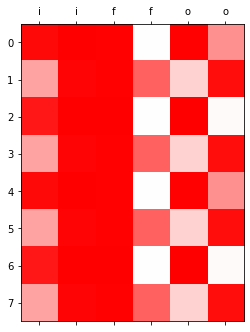
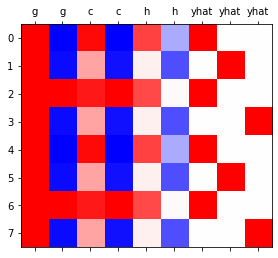
- 상단그림은 게이트의 값들만 시각화, 하단그림은 게이트 이외의 값들을 시각화
시각화의 해석I
plt.matshow(combinded1[-8:].data,cmap='bwr',vmin=-1,vmax=1);
plt.xticks(range(combinded1.shape[-1]),labels=['i']*2 + ['f']*2 + ['o']*2);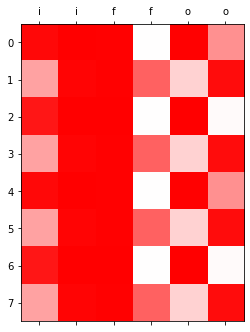
- input_gate, forget_gate, output_gate는 모두 0~1 사이의 값을 가진다.
- 이 값들은 각각 모두 \({\boldsymbol g}_t, {\boldsymbol c}_{t-1}, \tanh({\boldsymbol c}_t)\)에 곱해진다. 따라서 input_gate, forget_gate, output_gate 는 gate의 역할로 비유가능하다. (1이면 통과, 0이면 차단)
- input_gate: \({\boldsymbol g}_t\)의 값을 얼만큼 통과시킬지 0~1사이의 숫자로 결정
- forget_gate: \({\boldsymbol c}_{t-1}\)의 값을 얼만큼 통과시킬지 0~1사이의 숫자로 결정
- output_gate: \(\tanh({\boldsymbol c}_t)\)의 값을 얼만큼 통과시킬지 0~1사이의 숫자로 결정
시각화의 해석II
plt.matshow(combinded2[-8:].data,cmap='bwr',vmin=-1,vmax=1)
plt.xticks(range(combinded2.shape[-1]),labels=['g']*2 + ['c']*2 + ['h']*2 + ['yhat']*3);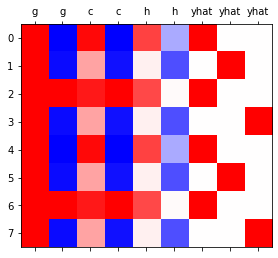
- 결국 \({\boldsymbol g}_t\to {\boldsymbol c}_t \to {\boldsymbol h}_t \to \hat{\boldsymbol y}\) 의 느낌이다. (\({\boldsymbol h}_t\)를 계산하기 위해서는 \({\boldsymbol c}_t\)가 필요했고 \({\boldsymbol c}_t\)를 계산하기 위해서는 \({\boldsymbol c}_{t-1}\)과 \({\boldsymbol g}_t\)가 필요했음)
- \({\boldsymbol h}_t= \tanh({\boldsymbol c}_t) \odot {\boldsymbol o}_t\)
- \({\boldsymbol c}_t ={\boldsymbol c}_{t-1} \odot {\boldsymbol f}_t + {\boldsymbol g}_{t} \odot {\boldsymbol i}_t\)
- \({\boldsymbol g}_t,{\boldsymbol c}_t,{\boldsymbol h}_t\) 모두 \({\boldsymbol x}_t\)의 정보를 숙성시켜 가지고 있는 느낌이 든다.
- \({\boldsymbol g}_t\) 특징: 보통 -1,1 중 하나의 값을 가지도록 학습되어 있다. (마치 RNN의 hidden node처럼!)
- \(\boldsymbol{g}_t = \tanh({\boldsymbol x}_t {\bf W}_{ig} + {\boldsymbol h}_{t-1} {\bf W}_{hg}+ {\boldsymbol b}_{ig}+{\boldsymbol b}_{hg})\)
- \({\boldsymbol c}_t\) 특징: \({\boldsymbol g}_t\)와 매우 비슷하지만 약간 다른값을 가진다. 그래서 \({\boldsymbol g}_t\)와는 달리 -1,1 이외의 값도 종종 등장.
print("first row: gt={}, ct={}".format(g[-8].data, cell[-8].data))
print("second row: gt={}, ct={}".format(g[-7].data, cell[-7].data))
#g[-7], cell[-7]first row: gt=tensor([ 0.9999, -0.9999]), ct=tensor([ 0.9647, -0.9984])
second row: gt=tensor([ 0.9970, -0.9554]), ct=tensor([ 0.3592, -0.9373])- \({\boldsymbol h}_t\) 특징: (1) \({\boldsymbol c}_t\)의 느낌이 있음 하지만 약간의 변형이 있음. (2) -1~1 사이에의 값을 훨씬 다양하게 가진다. (tanh때문)
print("first row: gt={}, ct={}, ht={}".format(g[-8].data, cell[-8].data,h[-8].data))
print("second row: gt={}, ct={}, ht={}".format(g[-7].data, cell[-7].data,h[-7].data))
#g[-7], cell[-7]first row: gt=tensor([ 0.9999, -0.9999]), ct=tensor([ 0.9647, -0.9984]), ht=tensor([ 0.7370, -0.3323])
second row: gt=tensor([ 0.9970, -0.9554]), ct=tensor([ 0.3592, -0.9373]), ht=tensor([ 0.0604, -0.6951])- 예전의문 해결
- 실험적으로 살펴보니 LSTM이 RNN보다 장기기억에 유리했음.
- 그 이유: RRN은 \({\boldsymbol h}_t\)의 값이 -1 혹은 1로 결정되는 경우가 많았음. 그러나 경우에 따라서는 \({\boldsymbol h}_t\)이 -1~1의 값을 가지는 것이 문맥적 뉘앙스를 포착하기에는 유리한데 LSTM이 이러한 방식으로 학습되는 경우가 많았음.
- 왜 LSTM의 \({\boldsymbol h}_t\)은 -1,1 이외의 값을 쉽게 가질 수 있는가? (1) gate들의 역할 (2) 마지막에 취해지는 tanh 때문
LSTM의 알고리즘 리뷰 I (수식위주)
(step1) calculate \({\tt ifgo}\)
\({\tt ifgo} = {\boldsymbol x}_t \big[{\bf W}_{ii} | {\bf W}_{if}| {\bf W}_{ig} |{\bf W}_{io}\big] + {\boldsymbol h}_{t-1} \big[ {\bf W}_{hi}|{\bf W}_{hf} |{\bf W}_{hg} | {\bf W}_{ho} \big] + bias\)
\(=\big[{\boldsymbol x}_t{\bf W}_{ii} + {\boldsymbol h}_{t-1}{\bf W}_{hi} ~\big|~ {\boldsymbol x}_t{\bf W}_{if}+ {\boldsymbol h}_{t-1}{\bf W}_{hf}~ \big|~ {\boldsymbol x}_t{\bf W}_{ig} + {\boldsymbol h}_{t-1}{\bf W}_{hg} ~\big|~ {\boldsymbol x}_t{\bf W}_{io} + {\boldsymbol h}_{t-1}{\bf W}_{ho} \big] + bias\)
참고: 위의 수식은 아래코드에 해당하는 부분
ifgo = xt @ lstm_cell.weight_ih.T +\
ht @ lstm_cell.weight_hh.T +\
lstm_cell.bias_ih + lstm_cell.bias_hh(step2) decompose \({\tt ifgo}\) and get \({\boldsymbol i}_t\), \({\boldsymbol f}_t\), \({\boldsymbol g}_t\), \({\boldsymbol o}_t\)
\({\boldsymbol i}_t = \sigma({\boldsymbol x}_t {\bf W}_{ii} + {\boldsymbol h}_{t-1} {\bf W}_{hi} +bias )\)
\({\boldsymbol f}_t = \sigma({\boldsymbol x}_t {\bf W}_{if} + {\boldsymbol h}_{t-1} {\bf W}_{hf} +bias )\)
\({\boldsymbol g}_t = \tanh({\boldsymbol x}_t {\bf W}_{ig} + {\boldsymbol h}_{t-1} {\bf W}_{hg} +bias )\)
\({\boldsymbol o}_t = \sigma({\boldsymbol x}_t {\bf W}_{io} + {\boldsymbol h}_{t-1} {\bf W}_{ho} +bias )\)
(step3) calculate \({\boldsymbol c}_t\) and \({\boldsymbol h}_t\)
\({\boldsymbol c}_t = {\boldsymbol i}_t \odot {\boldsymbol g}_t+ {\boldsymbol f}_t \odot {\boldsymbol c}_{t-1}\)
\({\boldsymbol h}_t = \tanh({\boldsymbol o}_t \odot {\boldsymbol c}_t)\)
LSTM의 알고리즘 리뷰 II (느낌위주)
- 이해 및 암기를 돕기위해서 비유적으로 설명한 챕터입니다..
- 느낌1: RNN이 콩물에서 간장을 한번에 숙성시키는 방법이라면 LSTM은 콩물에서 간장을 3차로 나누어 숙성하는 느낌이다.
- 콩물: \({\boldsymbol x}_t\)
- 1차숙성: \({\boldsymbol g}_t\)
- 2차숙성: \({\boldsymbol c}_t\)
- 3차숙성: \({\boldsymbol h}_t\)
- 느낌2: \({\boldsymbol g}_t\)에 대하여
- 계산방법: \({\boldsymbol x}_t\)와 \({\boldsymbol h}_{t-1}\)를 \({\bf W}_{ig}, {\bf W}_{hg}\)를 이용해 선형결합하고 \(\tanh\)를 취한 결과
- RNN에서 간장을 만들던 그 수식에서 \(h_t\)를 \(g_t\)로 바꾼것
- 크게 2가지의 의미를 가진다 (1) 과거와 현재의 결합 (2) 활성화함수 \(\tanh\)를 적용
- 느낌3: \({\boldsymbol c}_t\)에 대하여 (1)
- 계산방법: \({\boldsymbol g}_{t}\)와 \({\boldsymbol c}_{t-1}\)를 요소별로 선택하고 더하는 과정
- \(g_t\)는 (1) 과거와 현재의 결합 (2) 활성화함수 tanh를 적용으로 나누어지는데 이중에서 (1) 과거와 현재의 정보를 결합하는 과정만 해당한다. 차이점은 요소별 선택 후 덧셈
- 이러한 결합을 쓰는 이유? 게이트를 이용하여 과거와 현재의 정보를 제어 (일반적인 설명, 솔직히 내가 좋아하는 설명은 아님)
- 느낌4: \({\boldsymbol c}_t\)에 대하여 (2) // \({\boldsymbol c}_t\)는 왜 과거와 현재의 정보를 제어한다고 볼 수 있는가?
\(t=1\) 시점 계산과정관찰
(tensor([0.9065, 0.9999], grad_fn=<SelectBackward0>),
tensor([0.9931, 0.9999], grad_fn=<SelectBackward0>),
tensor([0.9931, 0.0014], grad_fn=<SelectBackward0>),
tensor([ 0.3592, -0.9373], grad_fn=<SelectBackward0>))\([0.9,1.0] \odot {\boldsymbol g}_t + [1.0,0.0] \odot {\boldsymbol c}_{t-1}\)
- forget_gate는 \(c_{t-1}\)의 첫번째 원소는 기억하고, 두번째 원소는 잊으라고 말하고 있음 // forget_gate는 과거(\(c_{t-1}\))의 정보를 얼마나 잊을지 (= 얼마나 기억할지) 를 결정한다고 해석할 수 있다.
- input_gate는 \(g_{t}\)의 첫번째 원소와 두번째 원소를 모두 기억하되 두번째 원소를 좀 더 중요하게 기억하라고 말하고 있음 // input_gate는 현재(\(g_{t}\))의 정보를 얼만큼 강하게 반영할지 결정한다.
- 이 둘을 조합하면 \({\boldsymbol c}_t\)가 현재와 과거의 정보중 어떠한 정보를 더 중시하면서 기억할지 결정한다고 볼 수 있다.
이 설명은 제가 좀 싫어해요, 싫어하는 이유는 (1) “기억의 정도를 조절한다”와 “망각의 정도를 조절한다”는 사실 같은말임. 그래서 forget_gate의 용어가 모호함. (2) 기억과 망각을 조정하는 방식으로 꼭 gate의 개념을 사용해야 하는건 아님
- 느낌5: \({\boldsymbol c}_t\)에 대하여 (3)
- 사실상 LSTM 알고리즘의 꽃이라 할 수 있음.
- LSTM은 long short term memory의 약자임. 기존의 RNN은 장기기억을 활용함에 약점이 있는데 LSTM은 단기기억/장기기억 모두 잘 활용함.
- LSTM이 장기기억을 잘 활용하는 비법은 바로 \({\boldsymbol c}_t\)에 있다.
- 느낌6: \({\boldsymbol h}_t\)에 대하여 - 계산방법: \(\tanh({\boldsymbol c}_t)\)를 요소별로 선택
- RNN, LSTM의 변수들 비교 테이블
| 과거정보 | 현재정보 | 과거와 현재의 결합방식 | 활성화 | 느낌 | 비고 | |
|---|---|---|---|---|---|---|
| RNN-\({\boldsymbol h}_t\) | \({\boldsymbol h}_{t-1}\) | \({\boldsymbol x}_t\) | \(\times\) \(\to\) \(+\) | \(\tanh\) | 간장 | |
| LSTM-\({\boldsymbol g}_t\) | \({\boldsymbol h}_{t-1}\) | \({\boldsymbol x}_t\) | \(\times\) \(\to\) \(+\) | \(\tanh\) | 1차간장 | |
| LSTM-\({\boldsymbol c}_t\) | \({\boldsymbol c}_{t-1}\) | \({\boldsymbol g}_t\) | \(\odot\) \(\to\) \(+\) | None | 2차간장 | gate를 열림정도를 판단할때 \({\boldsymbol x}_t\)와 \({\boldsymbol h}_{t-1}\)을 이용 |
| LSTM-\({\boldsymbol h}_t\) | None | \({\boldsymbol c}_t\) | None | \(\tanh\), \(\odot\) | 3차간장 | gate를 열림정도를 판단할때 \({\boldsymbol x}_t\)와 \({\boldsymbol h}_{t-1}\)을 이용 |
- RNN은 기억할 과거정보가 \({\boldsymbol h}_{t-1}\) 하나이지만 LSTM은 \({\boldsymbol c}_{t-1}\), \({\boldsymbol h}_{t-1}\) 2개이다.
- 알고리즘리뷰 :
- 콩물,과거3차간장 \(\overset{\times,+,\tanh}{\longrightarrow}\) 현재1차간장
- 현재1차간장, 과거2차간장 \(\overset{\odot,+,\tanh}{\longrightarrow}\) 현재2차간장
- 현재2차간장 \(\overset{\tanh,\odot}{\longrightarrow}\) 현재3차간장
LSTM이 강한이유
- LSTM이 장기기억에 유리함. 그 이유는 input, forget, output gate 들이 과거기억을 위한 역할을 하기 때문.
- 비판: 아키텍처에 대한 이론적 근거는 없음. 장기기억을 위하여 꼭 LSTM같은 구조일 필요는 없음. (왜 3차간장을 만들때 tanh를 써야하는지? 게이트는 꼭3개이어야 하는지?)
- 저는 사실 아까 살펴본 아래의 이유로 이해하고 있습니다.
- 실험적으로 살펴보니 LSTM이 RNN보다 장기기억에 유리했음.
- 그 이유: RRN은 \({\boldsymbol h}_t\)의 값이 -1 혹은 1로 결정되는 경우가 많았음. 그러나 경우에 따라서는 \({\boldsymbol h}_t\)이 -1~1의 값을 가지는 것이 문맥적 뉘앙스를 포착하기에는 유리한데 LSTM이 이러한 방식으로 학습되는 경우가 많았음.
- 왜 LSTM의 \({\boldsymbol h}_t\)은 -1,1 이외의 값을 쉽게 가질 수 있는가? (1) gate들의 역할 (2) 마지막에 취해지는 tanh 때문





